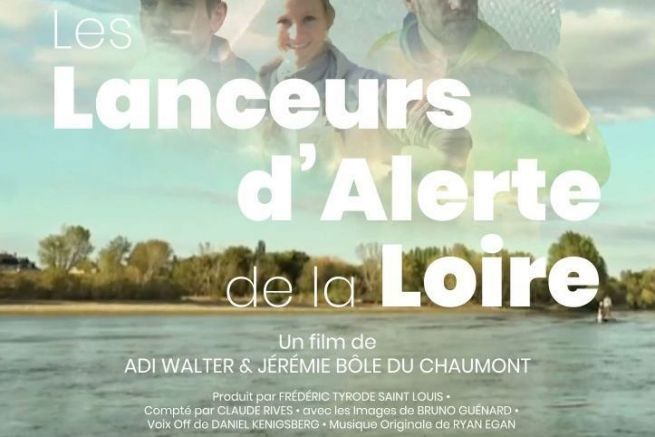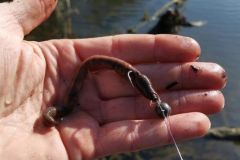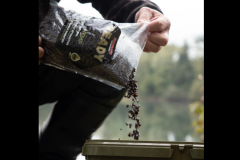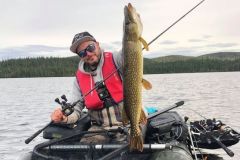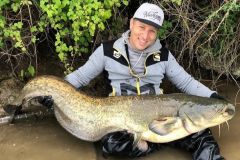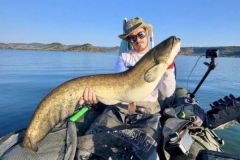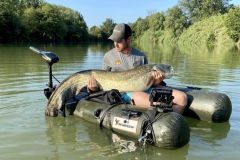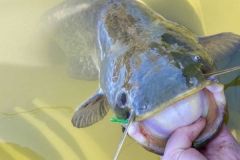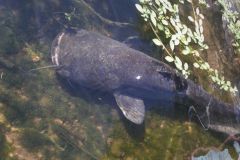The starting premise is rather relevant: to use a river, the symbol of life, its evolution through history, the acceleration of its degradation in recent years to crystallize the environmental and ecological issues we face in our time. It is a question of global warming, of access to water resources, of the inertia of the water tables which, in spite of the progress of intensive agriculture in terms of the use of phytosanitary products, still diffuse large quantities of pollutants linked to this activity in the water courses. Reference is also made to drug pollution, to the appearance and spread of the corbicula (Asian clam) throughout the French hydrographic network. We talk about the near disappearance of migratory fish species (Atlantic salmon, sea lamprey, shad, European eel), of the obstacles to their migration that are dams in particular. And there is a lot of talk about the catfish.
To address all of these points, the film crew relies on scientists, people from the Loire (inhabitants of the Loire), environmental educators and professional fishermen. All this seems rather solid except that this 52 minutes documentary quickly turns to bias... The catfish is redundantly pointed out while the professional fishing is presented as a job in danger that it is essential to preserve. This is what we remember in the end. Here is my analysis point by point.
The "science" to credit an anti-fish discourse
Professional fishermen scientists...
The first constitutive problem is to call upon scientists who are also professional fishermen on the Loire and members of the Loire Basin Committee. Relying on science makes the argument credible to the general public.
... that do not refer to the reference studies
This documentary oriented against the catfish completely neglects the results of studies conducted on the latter on the Rhone for example. This study entitled "The installation of the catfish in the Rhone basin: assessment of three decades of monitoring of the species" was conducted between 1988 and 2015 by the Federation of Fishing of 69 in partnership with Jean-Claude Tanzilli (when talking about the catfish in France this person remains unavoidable).
Catfish, regulator of its own species
This study shows first of all that the catfish population in France has reached equilibrium since the catfish acts as a regulator of its own species. It is therefore easy to understand that removing the big fish would have a counter-productive effect and would only revitalize the population, a population that responds to the classic pattern of the age pyramid where the youngest fish are the most represented in contrast to the oldest and largest fish (=the regulators). It is likely that the catfish population has reached its equilibrium point in the Loire, as elsewhere. And this is without counting its regulating effect on the Rhone on invasive species such as catfish, corbicles or the American crayfish.
Catfish, mostly on an empty stomach
Also, the numerous stomach samples taken during this study show that most of the time the catfish has an empty stomach. Like the pike, the catfish has a very high conversion index, that is to say that what it ingests is almost totally assimilated.
"Catfish is not a flying fish
For the scientists of the documentary, the catfish is a real problem of the Loire. It would be a species imported by Man in France 25 years ago to revive fish farming in the Centre Region. It is not quite honest to focus on this so-called problem since with the communications between the great European rivers, and in particular the Danube-Main-Rhine canal, its colonization of the French hydrographic network was inevitable. The catfish is indeed not a flying fish. The same thing happened with the ide melanote, the asp and now the goby... The current expansion of the goby is irresistible. In the documentary, cutaways regularly show pike-perch and carp, fish native to the Danube basin, like the catfish...
What to do with these fish from other waters? Close the channels? Impossible. To eradicate these fish ? Technically impossible, especially since, as far as catfish are concerned, this will have the effect of revitalizing the population (they are self-regulating of their own species). The only solution is to take note (especially since it is still our fault as humans) and move on, whether we are pro catfish or not.
Decline in migratory fish populations: who is really responsible?
Catfish?...
The catfish is presented as a risk of extinction of the native heritage species that are the Atlantic salmon, the sea lamprey, the shad and the European eel. We see a shot where the catfish are in ambush downstream of the fish pass of the EDF dam of Saint-Laurent-des-Eaux, ready to gobble up the species mentioned above. So be it. One cannot deny the impact of the catfish in this precise case which, opportunistic as any carnivore is, goes for the simplest. Except that of the dam or the catfish, what is the real problem?
Also, there is no reference to the Nantes muddy plug and to the salmon fishing with nets in the estuary, which largely hinders the upstream migration of Atlantic salmon... it's a shame.
And then, there is no reference to the fact that the population of asp has literally exploded in the Loire over the last 10 years, whereas the catfish is supposed to unravel everything.
... or professional fishing?
As we learn in the documentary, there are 100 pro fishermen on the Loire, 10 of whom specifically target migratory fish. This statement is apparently sufficient to consider the impact of these fishermen on migratory populations as negligible.
However, it is difficult to understand how we can be alarmed by the near disappearance of migratory fish species such as salmon, sea lamprey and European eel and yet continue to fish them for human consumption. One could easily speak of cognitive dissonance at this level.
We learn from the mouth of professional fishermen themselves that the eel is the only species that makes them live all season. The European eel is on the way to extinction in France but we still allow a handful of professionals to weaken the population even more? The elver harvest quota (young eels resulting from the reproduction of eels in the Sargasso Sea returning to grow up in fresh water) intended for human consumption is set at 23 tons (i.e. millions of individuals) for professional fishermen (marine and freshwater) for the 2020-2021 campaign. An aberration.
Professional fishermen, the only economic actors in the fishing industry?
Forget the sport fishermen...
The economic stake linked to professional fishing is highlighted thanks to the high economic value of migratory fish. In France, we have on the one hand 1,200,000 recreational freshwater fishermen and on the other hand 400 professional fishermen. Recreational freshwater fishing represents 2 billion euros per year. What economic balance are we talking about? Have we still not understood that nowadays a live fish caught for sport in catch and release would bring in a lot more money than the same dead fish in the nets of a few professional fishermen? Let us have a management policy based at least on the medium term...
... and fishing guide instructors
On the one hand, we have professional fishermen and on the other hand, professional recreational fishermen. By professional leisure fishermen, I am referring to the Fishing Guide Instructors who, in the same way as the professional fishermen, are "professionals" with the difference that they have to follow an expensive training course (about 5,000 euros) and pass a diploma to exercise their profession. Also, night fishing for catfish, for example, is forbidden for the latter while the former can practice their activity from 4 hours before sunrise to 4 hours after sunrise, using 200 specific lines for catfish fishing in particular, without any quota. In short, the Fishing Guide Instructors have few rights vis-à-vis their net fishing counterparts...
Does professional fishing really have a future?
Heritage and cultural values to defend at all costs?
Fishing in the Loire has always existed and under this pretext we should defend it no matter what. The professional fishermen claim to be both the alert launchers and they are the ones who deliver the coup de grace to the fish populations. We are not talking about professional fishermen at the end of their activity who would find themselves caught in the stranglehold of a sudden situation. No, the documentary explains that this activity is difficult for young people who want to practice it. It is very ironic. Maybe we should stop? Perhaps Man has so deregulated the environment that it no longer produces enough? Couldn't we propose reconversions to these professional fishermen, integrate them into the recreational fishing network, for example?
PCB pollution
In concrete terms, beyond being an economic and ecological sham, professional freshwater fishing is a health aberration. Fish are bioaccumulators of PCBs and in general it is advised to limit or not to consume freshwater fish in France.
"Professional fishing has a scientific interest"
This is a heritage technique that also has a great scientific interest apparently. So, let's limit their activity to that in this case. Why further pressurize endangered fish species?
"Taking the bull by the horns
The decline in fish populations is the result of a combination of factors such as overfishing, pollution, dams, crop irrigation, accelerated global warming, etc. Let's stop pointing the finger at the same person. The catfish is a victim of a misdemeanor, suffering from its large size. It is particularly dishonest to sensationalize and divulge false information to the general population which is unaware of many things about aquatic environments but which will remember that the sheatfish, this big ugly fish, is responsible for a good part of the problems of the Loire. The pike-perch was the devil 40 years ago, the pike (however native) before him, now it's the catfish.
Documentary still available in Replay on the website of the channel
